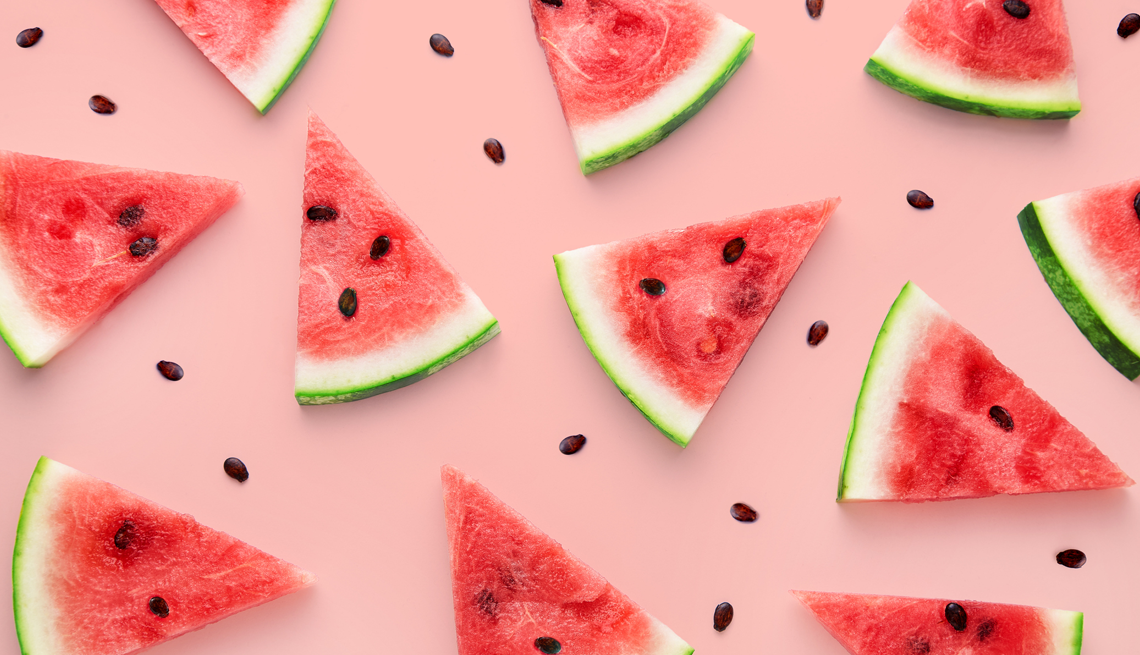AARP Hearing Center


Few things are more refreshing than crisp, juicy watermelon on a hot summer’s day. But don’t think of it as just an emblem of warm-weather fun. Consider it a dietary powerhouse. Watermelon is packed with nutrients that can make a big difference as you age, including some you won’t find more of in any other fresh fruit or vegetable. “When we’re looking to put healthy things in our diet, what a gift that we can have something like watermelon that is naturally sweet, delicious, filling and just chock-full of beneficial nutrients,” says Samantha Cassetty, registered dietitian in New York.
Here are five reasons you should add watermelon to your shopping list:
1. Helps your skin look younger
Beyond the refreshment factor, this may be why watermelon is the ultimate summertime fruit: It’s bursting with lycopene, the plant compound that makes tomatoes red. Studies have found it can protect your skin from UV radiation. Lycopene has benefits both inside your body and on your skin — you can even buy sunscreen made with it. For years, scientists considered tomatoes the best food source of the substance. But, it turns out, ruby-red watermelon provides 40 percent more than raw tomatoes.
“Watermelon is really, really, really one of the best sources of lycopene,” says Diane McKay, an assistant professor in the Friedman School of Nutrition Science and Policy at the Tufts University School of Medicine. “Tomatoes are another source, but you have to cook the tomato to get most of the lycopene released from the cell. With watermelon, you don’t have to do anything — you just cut it and eat it.”
Lycopene isn’t the fruit’s only source of sun protection. A two-cup serving also contributes one-quarter to one-half of your daily dose of vitamin C, which also protects your skin from damage due to UV rays.


Looking for a new way to enjoy your new favorite melon? Try José Andrés' recipe for Watermelon & Feta Salad from AARP’s Members Edition.
But beware: While these plant-based nutrients can help you fend off harmful rays, you still need to use sunscreen. Think of watermelon as a second line of defense — an internal one.
Lycopene and vitamin C do more to keep your skin looking youthful. Both nutrients also support collagen, which provides structure. That can help prevent fine lines and wrinkles.
As part of a balanced diet, “it could help your skin age better, with fewer signs of premature wrinkling and aging,” Cassetty says.
2. Protects your eyes
Bugs Bunny’s favorite snack isn’t the only food that can help safeguard your vision. Like carrots, watermelon boasts several nutrients that can lower your risk of age-related macular degeneration and cataracts.
- Lycopene: One study found that lycopene may reduce your risk of macular degeneration by as much as 30 percent. Other research has found it can help protect you from cataracts.
- Vitamin C: Getting vitamin C from a diet rich in fruits and vegetables — rather than from supplements — has been linked to lower risk of cataracts.
- Lutein and zeaxanthin: A 2022 study published in the journal Nutrients looked at data from more than 50,000 Americans. It found that participants who ate watermelon had higher levels of lutein and zeaxanthin than those who didn’t. That pair of plant compounds is important for eye health.
- Vitamin A: Watermelon also provides some vitamin A, the nutrient that gives carrots their reputation as a vision-booster.
More research is needed to definitively link watermelon to eye health. But thanks to all those benefits, the renowned Cleveland Clinic recommends it.






























































More on Health
13 Foods Packed With Water
Refreshing, delicious ways to get plenty of H₂0The 10 Best Superfoods for Your Eyes
Protect your vision with these nutritious (and delicious) foods
Try These Tips for Living a Healthier Life
Small changes can add up to big mental and physical results
Recommended for You